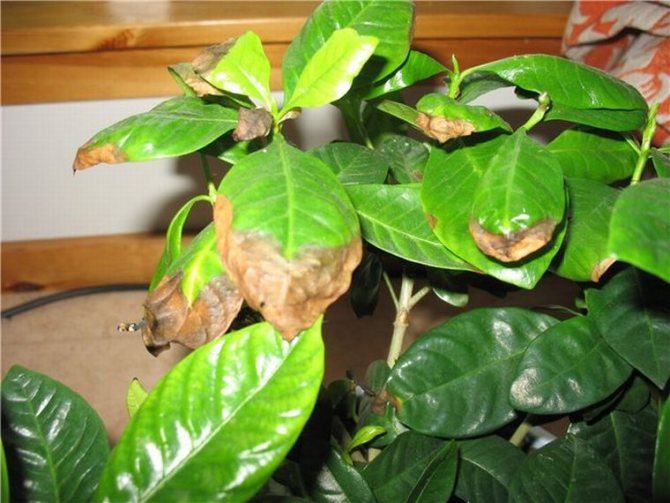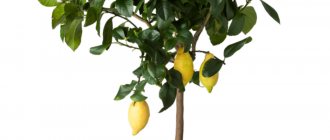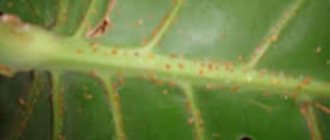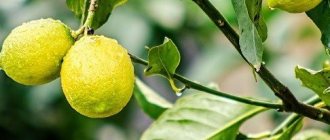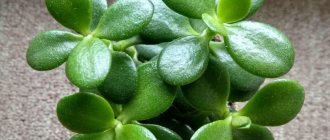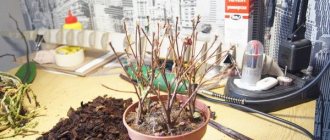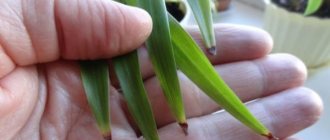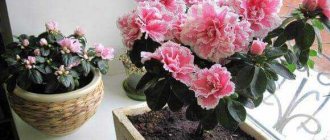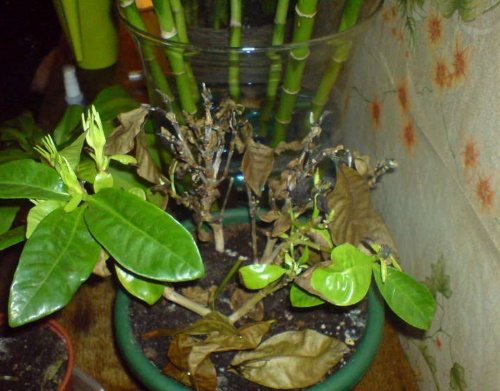
Despite the gorgeous appearance and beautiful flowering, not all growers undertake to grow a capricious gardenia. And their fear is completely justified, because the plant is distinguished by exaggerated requirements and extreme sensitivity. Most often, one of the problems is drying and falling foliage. There may be several reasons why the leaves of the jasmine gardenia turn black and fall off. In most cases, this is the result of violations in the care or a change in the conditions of keeping the flower. However, do not forget that various insects are very fond of gardenia and sometimes it is they who cause such a phenomenon. There is no need to be upset, because the timely detection of the problem will help to accurately diagnose and take measures to save the bush.
Gardenia got its name because its flowers are absolutely the same as those of jasmine, moreover, they have a characteristic aroma for it. The plant itself is an evergreen shrub. Interestingly, this variety is the only one of its kind that is capable of growing at home.
Result # 1. Gardenia leaves turn yellow
This is the most common gardenia ailment. The leaves turn pale, turn yellow, sometimes - only between the veins. In any case, such manifestations indicate unfavorable conditions for keeping the plant.
The reasons:
1. Wrong watering regime
Very often, gardenia turns yellow when the soil is excessively moistened or, conversely, after drying. Watering is needed immediately after the top layer of the earth dries up by 1-2 phalanges of a finger (depending on the size of the plant and the depth of the pot), it is impossible to wait for the complete drying of the earthen coma.
Water quality also plays a huge role and can easily lead to yellowing of gardenia leaves. A capricious plant recognizes only well-separated, ideally boiled or filtered (from chlorine) water. And only warm! Cold and hard water is not suitable.
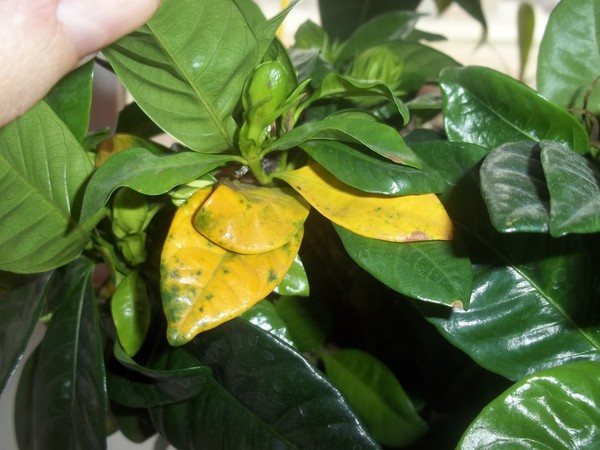

Yellowing of gardenia leaves due to overflow
2. Wrongly chosen substrate
When thinking about why gardenia turns yellow, do not ignore the substrate in which it grows. Gardenia prefers acidic soils; it will feel bad on all others. In neutral and, especially alkaline, substrates, its roots cease to assimilate the necessary substances to the required extent.
An acidic substrate (pH 4-5) can be purchased at a flower shop called Azalea or Gardenia. In the finished substrate, you can independently mix coniferous needles - for additional acidification.
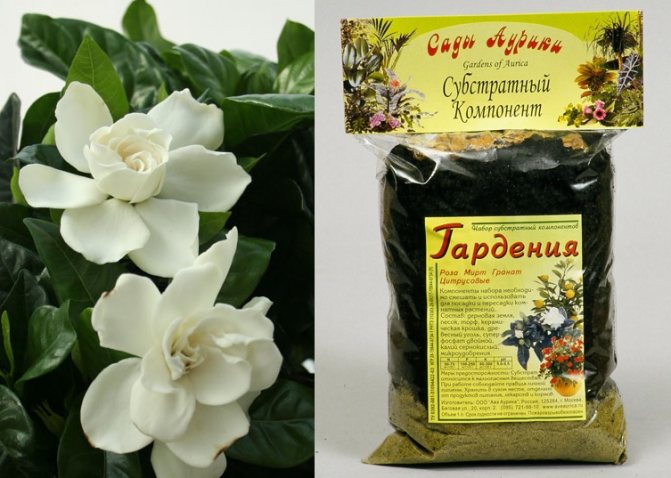

Gardenia soil must be acidic
Unfortunately, even acidic soil alkalizes over time. Tap water is alkaline in most regions. To prevent changes in soil response, water the gardenia with acidified water every 10 days. For acidification use:
- Citric acid - several crystals (at the tip of a knife) are dissolved in 1 liter of water;
- Oxalic acid - 1/3 tsp for 3 liters of water, after which it is insisted for at least 3-4 days. Oxalic acid is good because it not only acidifies water, but also precipitates calcium salts, an excess amount of which is harmful to most plants;
- Lemon juice - 2-3 drops per 1 liter of water;
- Peat - 200 g of peat is poured into 3 liters of water, insisted for a day.
3. Chlorosis
Chlorosis manifests itself in uneven yellowing of gardenia leaves: the veins remain green against the background of yellowing, sometimes almost discolored, plates. Chlorosis is associated with a lack of iron in the soil. By the way, chlorosis in gardenia is almost a "occupational disease", the war with it must be waged constantly, otherwise the flower will surely hurt.
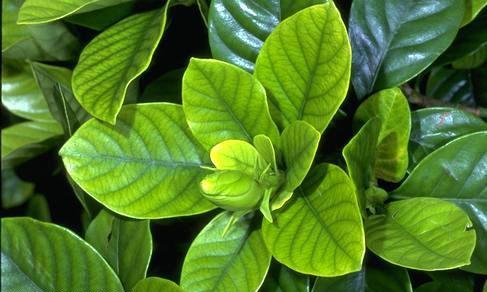

Iron chlorosis of gardenia
Chlorosis occurs when the soil is alkalized, so the first step for prevention should be watering the gardenia with acidified water. With clear signs of chlorosis, proceed as follows:
- spray and water gardenia with iron-containing preparations (Ferovit, Micro-Fe, etc.);
- or make homemade iron chelate;
- as an additional source of iron - bury rusty nails in the soil.
4. Lack of lighting
Gardenia turns yellow even with a lack of light. In this case, the leaves turn pale, and evenly, on all branches of the bush.
5. Lack of nutrition
Gardenia, like any ornamental plant, needs additional feeding during the period of growth and flowering. Find a good compound fertilizer with additional iron and magnesium. Gardenia has a special love for these two trace elements. We already wrote about iron above - gardenia reacts to its lack by yellowing the leaves (chlorosis). Lack of magnesium also leads to blanching of the leaves. Magnesium sulfate used for spraying at a concentration of 20 g per 10 liters of water will help to eliminate this process.
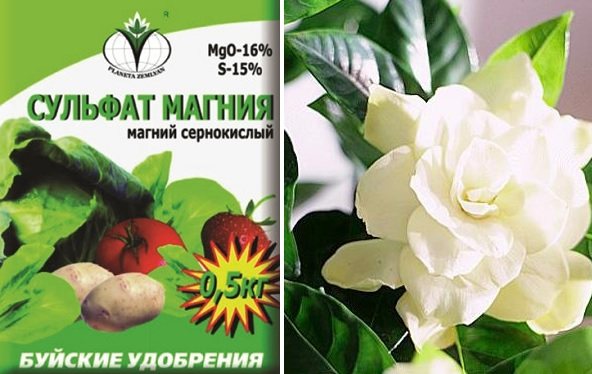

Magnesium sulfate heals the plant, accelerates and enhances flowering
Plant growing recommendations
In order for a flower to grow beautiful and healthy, you must follow some rules:
- do not keep the gardenia in direct sunlight;
- avoid sudden changes in temperature;
- do not flood the plant, but also do not let the earth dry out;
- maintain air humidity in the room;
- ensure the acidity of the soil;
- during the flowering period, do not change the position of the container with gardenia;
- water for irrigation should be slightly warm and soft;
- inspect the leaves daily for the timely detection of spider mites;
- sprinkle the leaves with water every day, and once a week with Epin (plant growth regulator).
Back to the table of contents
Result # 2. Gardenia leaves fall
This also happens often. This is due to the stress that your plant has recently received.
The reasons:
1. Lack of watering
When gardenia begins to sprinkle with leaves, for example, they turn yellow sharply and crumble or fall off without changing their appearance, this is a consequence of drying. Regulate watering, and to combat stress, use spraying with an immunity stimulant - epin. It will not be superfluous to carry out "resuscitation" for the gardenia. Spray it with water or epin solution and put a plastic bag (garbage, for example) on the bush. Leave in this form for a day. This is a great way to quickly tidy up your dried gardenia.
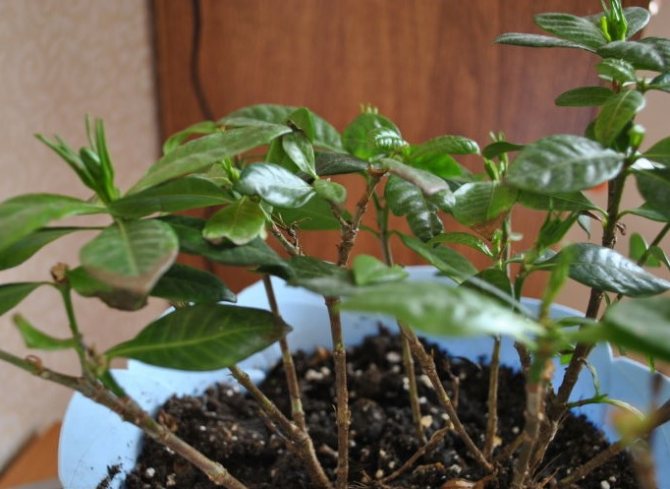

Drying an earthen coma leads to leaf fall on gardenia
2. Draft
Gardenia leaves fall if it is "blown". Of course, gardenias lovers know that she loves coolness. However, it is not worth placing it near an open window from which it is blowing.
Diseases and pests
Consider the most common ailments that gardenia is susceptible to, and find out what to do with these problems.
Drying
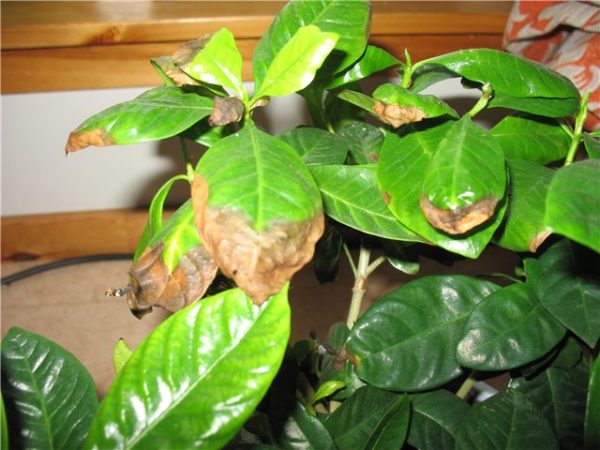

Most often, gardenia leaves dry out due to insufficiently acidic soil. What if the plant is dry? To eliminate the problem, it is necessary to add a few grains of citric acid or a few drops of lemon juice to the water when watering.
If the plant dries up already strongly, you need to check if there is a sharp drop in day and night temperatures. If a similar problem exists, it must be eliminated, since it is to sharp temperature changes that gardenia reacts by drying out and dropping foliage.
White aphid
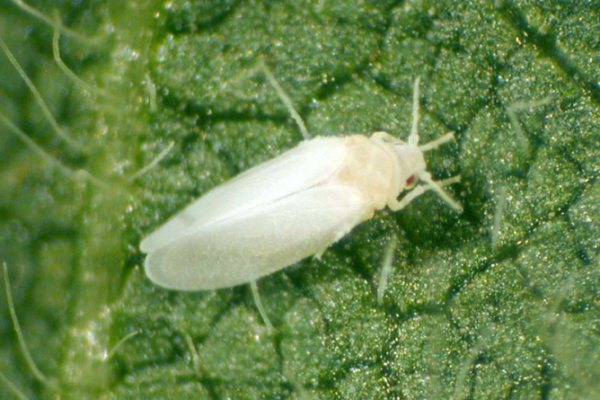

This harmful insect infects the leaves and stems of gardenia, and it is also one of the reasons why gardenia buds fall off. Note that the white aphid reproduces at a fairly rapid pace, therefore, urgent measures must be taken when gardenia is infected with this pest.
Result # 3. Gardenia turns black (leaves dry)
Gardenia leaves dry out quite often. If this happens in small quantities, then you should not worry - this is a completely natural process. You need to sound the alarm when the phenomenon is massive.
The reasons:
1. Bay
Dry the soil and adjust watering. Avoid "swamps" in the plant pot. Make drainage holes urgently if not available.
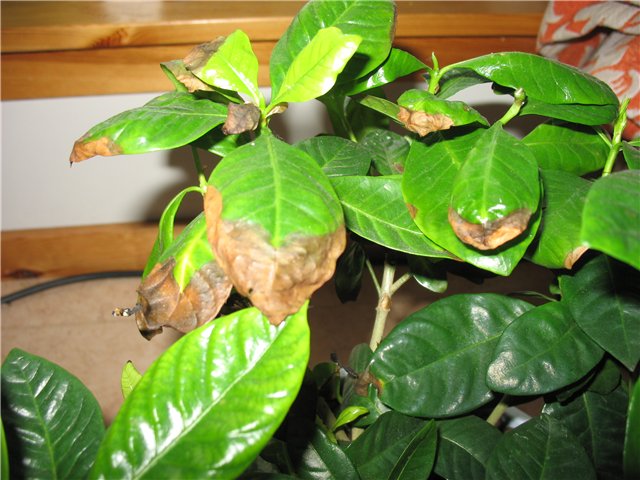

Gardenia leaves begin to dry out if the plant is watered too often.
2. Frostbite and draft
Gardenia is a sissy, so a sharp drop in temperature downward can cause blackening of the leaves. The optimal temperature range is 18-24 ° C.
3. Pests
Spider mites especially often hunt gardenia. It is he who causes the gradual blackening of the leaves, as it draws juice from them.
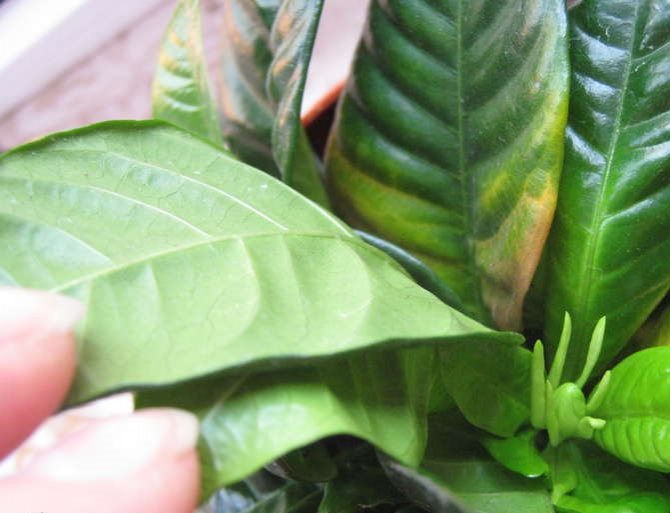

Manifestations of spider mites on gardenia
Features of the
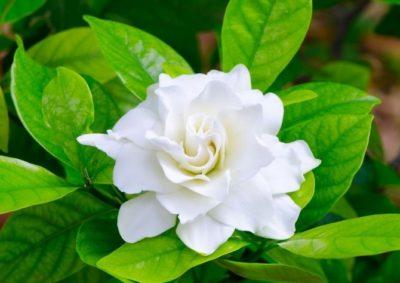

The gardenia has leaves of a rich, dark green color, opposite, rarely in whorls of 3. There is also a peristo-loop venation and a cross-opposite leaf arrangement.
As you know, the foliage is still distinguished by triangular stipules, a smooth surface and a glossy shine. Foliage length up to 10cm. Among florists, gardenia is valued for the decorative look of foliage, an evergreen shrub looks spectacular, even in the absence of flowers.
Result # 4. Gardenia buds fall off
But this is very unpleasant. You are expecting that the recruited gardenia buds are about to open, and they fall off for no reason at all. It's a shame, but there are reasons for this.
The reasons:
1. Dry air
Gardenia is a plant native to the humid tropics. Loves humid air, refuses to bloom in dry climates and throws buds. Moisten the air around the flower. How to do it? For example, like this:
- Place the gardenia pot on a pallet of damp expanded clay. The pallet should be larger than the base of the pot so that moisture from expanded clay is transferred to the leaves;
- spray the gardenia more often, being careful not to get on the buds and opened flowers;
- place a jar of water next to the plant (indoor fountain, aquarium, etc.);
- use a humidifier.
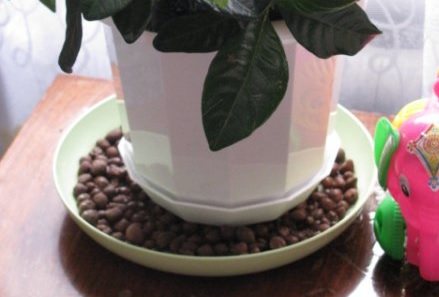

Gardenia on a pallet with wet expanded clay
2. Draft
Protect the gardenia with buds from drafts, otherwise the flowering will be postponed to the next year.
3. Temperature fluctuations
Too drastic changes in temperature conditions can lead to stress and, as a result, the discharge of gardenia buds.
4. Changing the location, turning the pot relative to the light source
It is undesirable to twist a flower with a set of buds. Some specimens tolerate this normally, while others react by drying out the pedicels.
5. Untimely transplant
Gardenias are usually sold with flowers or buds in stores. Transplanting a plant in this state does not lead to anything good, the buds begin to crumble.
What it is?
ATTENTION: This plant belongs to the numerous Madder family. More than 250 varieties of gardenia are known in the world. The growing area is the Far East, India, China. In the wild, it grows in South America, East Asia.
The flower itself is an evergreen tropical shrub. At home, only one species is grown - the jasmine gardenia.... This miniature plant is up to 50 cm tall and has white flowers. The size of the inflorescences is 7-10cm in diameter. A characteristic feature of the exotic beauty is a pleasant aroma, with a subtle hint of jasmine.We wrote about the beneficial properties of gardenia in a separate article.
Care problems
Gardenia jasmine is a rather capricious plant, requires careful attitude and adherence to certain rules, only after that it is possible to obtain a beautiful flowering specimen.
The main problems that can arise when growing jasmine gardenia and their solution:
- Yellowing of leaves often associated with unsuitable soil, it must be acidic. You can fix this by watering the ground with a weak solution of lemon juice. Also, yellowing of the leaves is observed with a lack of iron; fertilizers containing this element should be used.
- If a leaves turn black and fall, then most often this is due to improper watering and excess moisture. It is necessary to bring this factor back to normal.
- Falling buds observes with a sharp change in the situation, for example, if the gardenia is moved to another room, lack of lighting, low humidity, transplanting during preparation for flowering. In order to avoid this problem, you should immediately find a suitable place for the plant and follow all care recommendations.
- Lack of flowering often due to the fact that at night there is an increased air temperature, while the buds are laid at 16-18 ºC.
